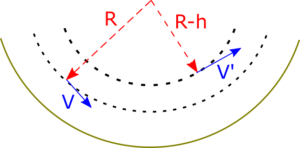Possibly my favourite amusement park ride I have ever tried was called a Schiffschaukel, which is German for “ship swing”. It was powered only by the rider, with no motor of any kind. With enough skill, you could make a complete 360° vertical loop! In place of the rope or chain links in an ordinary swing, it was supported by rigid struts, which helped achieve a complete rotation. I loved the physical challenge of it. It was easy to start it rocking. I also managed to get my body above the horizontal, but not to make a complete loop. However one man I watched could not only achieve a loop, but gauged his speed so as to hang upside down for a few seconds, neck craned forward to watch the ground, before he gradually tipped over.

In my experience most people, including Germans, have never heard of it. Wikipedia calls it a “ship swing”, in contrast to a “pirate ship” ride which is motorised. I have been on a couple of the latter rides in Australia: huge structures which seat dozens of people, and are quite different to the self-propelled swing. The unpowered type date from the 1800s apparently; many held two people, and had ropes to pull on. The German language Wikipedia has more information: here is an automatic translation. Also it turns out there is a modern Estonian sport kiiking (meaning “swinging”) which is the same concept. The current world record for a revolution is a swing with radius just over 7 metres, achieved by an Olympic medal-winning rower.
But how is it even possible to make a loop? I found it counter-intuitive, like pulling yourself up by the bootstraps, as the proverbial saying goes. Similarly, I recently learned of “pump tracks” for bicycles, from my brother. It is possible to propel yourself around such a course, which consists of mounds and banked corners, without pedalling! The energy comes from raising or lowering your body with the correct timing. In fact you can even propel yourself on flat ground this way, by making appropriate turns and body maneuvers.

Conservation of angular momentum explains both scenarios. Consider a circular, concave segment of track, as with the ship swing. Approximate the person, plus bike or “ship”, as a point object with mass ![]() . Suppose this point, their centre-of-mass, moves on a circle with radius
. Suppose this point, their centre-of-mass, moves on a circle with radius ![]() (note this is less than the radius of the track arc). The angular momentum, as determined from the centre of curvature, is
(note this is less than the radius of the track arc). The angular momentum, as determined from the centre of curvature, is ![]() , where
, where ![]() is the speed. (Technically this is a vector cross-product, but in this simple example where the vectors are at 90°, we can more or less treat it as an ordinary multiplication of numbers.) Now suppose the rider stands up straighter, so their centre of mass moves a “height”
is the speed. (Technically this is a vector cross-product, but in this simple example where the vectors are at 90°, we can more or less treat it as an ordinary multiplication of numbers.) Now suppose the rider stands up straighter, so their centre of mass moves a “height” ![]() towards the centre of curvature. The angular momentum is
towards the centre of curvature. The angular momentum is ![]() , where
, where ![]() is the new speed. But since angular momentum is conserved, this must match the previous expression, hence:
is the new speed. But since angular momentum is conserved, this must match the previous expression, hence:
![]()
The speed has increased! Note the rider put work in, by not only resisting the centrifugal acceleration ![]() , but moving against it, in the opposite direction. The forces can be severe. For a swing to barely reach the top, it must have a speed
, but moving against it, in the opposite direction. The forces can be severe. For a swing to barely reach the top, it must have a speed ![]() at the bottom of the arc, by conservation of kinetic and gravitational potential energy. Here
at the bottom of the arc, by conservation of kinetic and gravitational potential energy. Here ![]() is the “acceleration” due to gravity. The centripetal acceleration at the lowest part is
is the “acceleration” due to gravity. The centripetal acceleration at the lowest part is ![]() , which is independent of the radius. Including the weight due to gravity gives a total of
, which is independent of the radius. Including the weight due to gravity gives a total of ![]() — that is, a g-force of 5!
— that is, a g-force of 5!
The swing rider should probably bend their knees when reaching the maximum height of their arc, to reverse the process and complete the cycle. If their speed is zero at this point (so a full revolution is not achieved), crouching has no effect on the speed, which is zero after all. In this case the maximum speed — measured when at the lowest part of the circle — grows by the fixed proportion ![]() with each swing. This is exponential growth! Once revolution is achieved, the rider can gain further speed by crouching at the top of the circle. While this reduces their speed by the same proportion
with each swing. This is exponential growth! Once revolution is achieved, the rider can gain further speed by crouching at the top of the circle. While this reduces their speed by the same proportion ![]() , over one revolution there is a net gain, since the speed at the bottom is greater due to gravitational fall.
, over one revolution there is a net gain, since the speed at the bottom is greater due to gravitational fall.
1/2 m Vlow^2 = mg2R + 1/2 m Vtop^2
Vlow^2 = 4gR + Vtop^2
If Vtop is speed before crouch, then should really use Vtop/ratio. So:
Vlow^2*ratio^2 = 4gR + Vtop^2/ratio^2
Suppose speed V just before bottom. Then V*ratio after standing. At top, before crouch, Vtop^2 = V^2*ratio^2 – 4gR. After crouch, new speed^2 is: Vtop^2/ratio^2 = V^2 – 4gR/ratio^2. At bottom, before standing, Vlow^2 = V^2 + 4gR(1-1/ratio^2).
1/ratio = (R-h)/R = 1-h/R. So 1-1/ratio^2 = 1 – (1-h/R)^2 = 2h/R – h^2/R^2
So 4gR( … ) = 8gh – 4gh^2/R = 4gh(2-h/R).
So with each revolution, the kinetic energy increases by a fixed amount (not fixed proportion). This is linear growth. Hence the speed increases indefinitely, but slowing rate. Of course this ignores friction, the rider’s strength, etc., assumes instantaneous repositioning
On a pump track the strategy is analogous: in a valley you should stand up, and over a bump you should crouch down, as one webpage explains. In both cases you move closer to the centre of curvature. In internet forums, people say similar motions arise naturally in skateboarding, surfing, snowboarding, and other sports. Returning to the ship swing, I was not told any strategy at the time. On certain swings I sensed my speed diminish, so knew I had made a mistake. At the bottom of the swing, when the sum of centrifugal force and gravity is maximum, it felt safer to “go with the flow”, and unnatural to resist. But resist is exactly what I should have done.